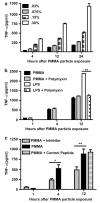Role of the Toll-like receptor pathway in the recognition of orthopedic implant wear-debris particles
- PMID: 21592562
- PMCID: PMC3716294
- DOI: 10.1016/j.biomaterials.2011.04.046
Role of the Toll-like receptor pathway in the recognition of orthopedic implant wear-debris particles
Abstract
The inflammatory response to prosthetic implant-derived wear particles is the primary cause of bone loss and aseptic loosening of implants, but the mechanisms by which macrophages recognize and respond to particles remain unknown. Studies of innate immunity demonstrate that Toll-like receptors (TLRs) recognize pathogen-associated molecular patterns (PAMPs) and danger-associated molecular patterns (DAMPS). All TLRs signal through myeloid differentiation factor 88 (MyD88), except TLR3 which signals through TIR domain containing adapter inducing interferon-beta (TRIF), and TLR4 which signals through both MyD88 and TRIF. We hypothesized that wear-debris particles may act as PAMPs/DAMPs and activate macrophages via TLRs. To test this hypothesis, we first demonstrated that inhibition of MyD88 decreases polymethylmethacrylate (PMMA) particle-induced production of TNF-α in RAW 264.7 macrophages. Next we compared particle-induced production of TNF-α among MyD88 knockout (MyD88(-/-)), TRIF knockout (TRIF(-/-)), and wild type (WT) murine macrophages. Relative to WT, disruption of MyD88 signaling diminished, and disruption of TRIF amplified the particle-induced production of TNF-α. Gene expression data indicated that this latter increase in TNF-α was due to a compensatory increase in expression of MyD88 associated components of the TLR pathway. Finally, using an in vivo model, MyD88(-/-) mice developed less particle-induced osteolysis than WT mice. These results indicate that the response to PMMA particles is partly dependent on MyD88, presumably as part of TLR signaling; MyD88 may represent a therapeutic target for prevention of wear debris-induced periprosthetic osteolysis.
Copyright © 2011 Elsevier Ltd. All rights reserved.
Figures




Similar articles
-
Aging and contribution of MyD88 and TRIF to expression of TLR pathway-associated genes following stimulation with Porphyromonas gingivalis.J Periodontal Res. 2015 Feb;50(1):89-102. doi: 10.1111/jre.12185. Epub 2014 May 24. J Periodontal Res. 2015. PMID: 24862405 Free PMC article.
-
Regulator of calcineurin 1 differentially regulates TLR-dependent MyD88 and TRIF signaling pathways.PLoS One. 2018 May 25;13(5):e0197491. doi: 10.1371/journal.pone.0197491. eCollection 2018. PLoS One. 2018. PMID: 29799862 Free PMC article.
-
PKC-alpha controls MYD88-dependent TLR/IL-1R signaling and cytokine production in mouse and human dendritic cells.Eur J Immunol. 2010 Feb;40(2):505-15. doi: 10.1002/eji.200939391. Eur J Immunol. 2010. PMID: 19950169
-
The role of TLR and chemokine in wear particle-induced aseptic loosening.J Biomed Biotechnol. 2012;2012:596870. doi: 10.1155/2012/596870. Epub 2012 Oct 21. J Biomed Biotechnol. 2012. PMID: 23193363 Free PMC article. Review.
-
The structural network of inflammation and cancer: merits and challenges.Semin Cancer Biol. 2013 Aug;23(4):243-51. doi: 10.1016/j.semcancer.2013.05.003. Epub 2013 May 24. Semin Cancer Biol. 2013. PMID: 23712403 Review.
Cited by
-
The complex cascade of cellular events governing inflammasome activation and IL-1β processing in response to inhaled particles.Part Fibre Toxicol. 2016 Aug 12;13(1):40. doi: 10.1186/s12989-016-0150-8. Part Fibre Toxicol. 2016. PMID: 27519871 Free PMC article. Review.
-
Joint replacement surgery and the innate immune system.J Long Term Eff Med Implants. 2014;24(4):253-7. doi: 10.1615/jlongtermeffmedimplants.2014010627. J Long Term Eff Med Implants. 2014. PMID: 25747028 Free PMC article.
-
Role of macrophages in the biological reaction to wear debris from joint replacements.J Long Term Eff Med Implants. 2014;24(4):259-65. doi: 10.1615/jlongtermeffmedimplants.2014010562. J Long Term Eff Med Implants. 2014. PMID: 25747029 Free PMC article.
-
Enhancing the immunomodulatory osteogenic properties of Ti-Mg alloy by Mg2+-containing nanostructures.Regen Biomater. 2024 Aug 29;11:rbae104. doi: 10.1093/rb/rbae104. eCollection 2024. Regen Biomater. 2024. PMID: 39372848 Free PMC article.
-
Toll-like receptors-2 and 4 are overexpressed in an experimental model of particle-induced osteolysis.J Biomed Mater Res A. 2014 Sep;102(9):3004-11. doi: 10.1002/jbm.a.34972. Epub 2013 Oct 7. J Biomed Mater Res A. 2014. PMID: 24115330 Free PMC article.
References
-
- Harris WH. Wear and periprosthetic osteolysis: the problem. Clin Orthop Relat Res. 2001:66–70. - PubMed
-
- Day MJ, Butterworth SJ, Palmer MR, Case CP. Characterization of wear debris associated with aseptic loosening of a canine hip prosthesis. J Comp Pathol. 1998;119:89–93. - PubMed
-
- Ingham E, Fisher J. The role of macrophages in osteolysis of total joint replacement. Biomaterials. 2005;26:1271–86. - PubMed
-
- Jacobs JJ, Roebuck KA, Archibeck M, Hallab NJ, Glant TT. Osteolysis: basic science. Clin Orthop Relat Res. 2001:71–7. - PubMed
-
- Medzhitov R, Preston-Hurlburt P, Janeway CA., Jr A human homologue of the Drosophila Toll protein signals activation of adaptive immunity. Nature. 1997;388:394–7. - PubMed
Publication types
MeSH terms
Substances
Grants and funding
LinkOut - more resources
Full Text Sources

